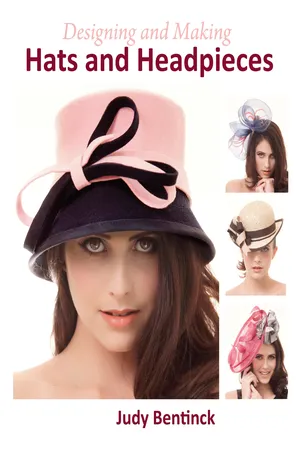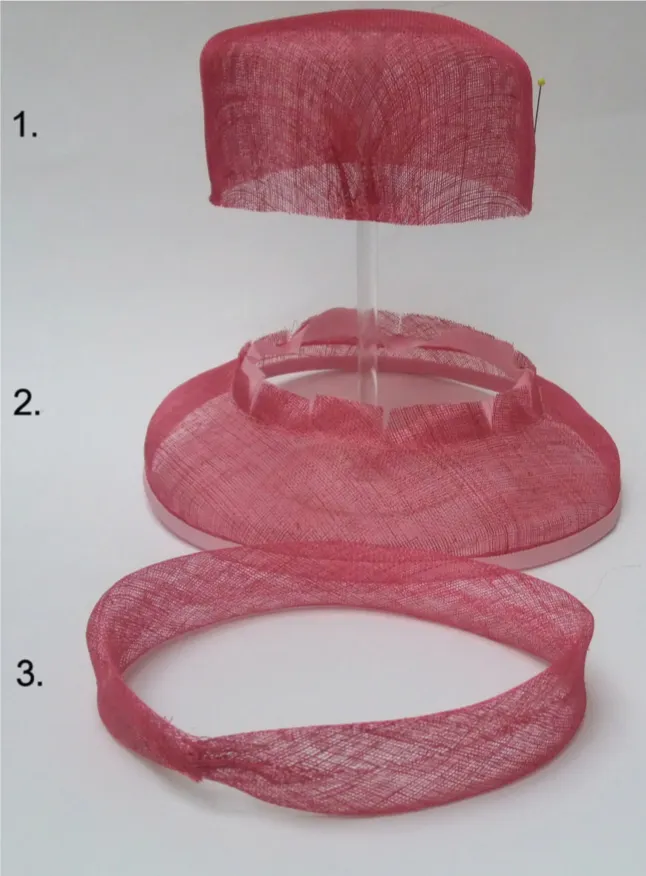![]()
Judy Bentinck Millinery. Style: parisisal pillbox hat. Photographer: Alistair Cowin. Model: Tamlyn Williams. Make-up and hair: Sammy Carpenter.
Why do people wear hats? To keep the rain off, to keep warm, to be part of a team, to shield the sun from their eyes – or for no practical reason, simply to look lovely. Hats are sexy and the process of creating something that is both a sculptural work of art and an alluring, flattering adornment to a woman’s outfit is sexy too, and enormously satisfying. I love it and in this book I’ll show you how to do it.
Wearing a hat for style rather than just for need has been part of all cultures for thousands of years. Traditional millinery lost favour for a while in the 1960s, in the UK at least, as young people dictated fashion for the first time in history, with the flower-power rebellion and back-combed bouffant hairdos taking the place of the conventional crowning glory.
In Britain Princess Diana almost single-handedly reignited the millinery industry and, while the Queen has never stopped wearing them and Ascot has always demanded them, the wedding of Prince William and Kate Middleton certainly focused a lot of attention on hats and their wearers. Today special occasions are full of beautiful headwear – from fabulous fascinators to pretty pillboxes to colossal cartwheels!
I have always loved hats. As a child I was one of the few girls who happily wore their hat to school, come rain or shine. At college I would scour charity shops for perky titfers or huge floppy brimmed creations, and I always sported a flat cap for weekend walks.
In my early career as a costume designer and wardrobe supervisor I occasionally had to create hats but I had no real idea how to do it – I didn’t know what a block was until my first millinery lesson in 2000 but that was the day I fell in love! It was so exciting to discover that millinery involved sculpture, textiles, style, colour, flair, proportion and, most of all, passion!
Today I combine running my couture millinery business with teaching. I love passing on the traditional skills that were taught to me by Rose Cory, Royal Warrant Holder, and watching the delight on the faces of my students as they experience the same excitement at this most creative of crafts. It has prompted me to write this book, to let you, the reader, discover for yourself the joy of creating something beautiful and wearable. To be inspired and excited and to open up a new world of all things hats!
![]()
Judy Bentinck Millinery. Style: silk dupion-covered cocktail hat. Photographer: Alistair Cowin. Model: Tamlyn Williams. Make-up and hair: Sammy Carpenter.
| Chapter 2 So What is Millinery? | 2 |
Millinery is the term used to describe the craft of making hats and headpieces for women. The word milliner derives from the seventeenth century when Milan in Italy was the centre for the beautiful fine straws, ribbons and general haberdashery suitable to trim and create ladies’ hats. Salesmen who travelled across Europe to Britain became known as ‘the men from Milan’ or ‘Milaners’, which evolved into milliners. (Men’s hats on the other hand are made by a hatter. There are milliners who do both, for example the wonderful and prolific Stephen Jones has a range called Miss Jones for women and Boy Jones for men.)
There are several well known idioms about hat-making and hats in general; you may have heard of some of them but might not be aware of how they came into being. Being as ‘mad as a hatter’, for example, was an expression pertaining to the unfortunate side-effects of working with mercury nitrate, a chemical used most notably during the Victorian era to soften fur in the felt-making process. Although these feltmakers were known to drink copiously as a result of their dusty working conditions, it was the long-term inhalation of mercury that poisoned the hatters and produced a number of inebriate symptoms, which often developed into tremors, delirium, paralysis and eventual death. Mercury had been removed from the process in Britain by the end of the nineteenth century but in some areas of the United States its use continued until as recently as the early 1940s. Mercury poisoning was known as the ‘Danbury shakes’ in the US owing to the concentration of hat-making in Danbury, Connecticut.
There are several other expressions from the times when hats were commonplace which have survived to the present and are used in everyday speech without us even thinking about the original meaning. This goes to show what an important clothing item hats always were until the decline of the hat-making industry in the 1960s, and how, throughout the different fashions and styles of the decades, the hat remained an essential accessory. Idioms like ‘keep it under your hat’ (to keep a secret), ‘take my hat off to you’ (show respect, praise or admiration), ‘to pull it out of a hat’ (achieve a surprise or trick), ‘at the drop of a hat’ (to act quickly, instantly), ‘to wear more than one hat’ (having lots of jobs or responsibilities) and ‘old hat’ (out of date or old-fashioned) all give us a glimpse into the past. The word has also been used more recently, for example in the 1980s Paul Young song ‘Wherever I Lay My Hat (That’s My Home)’, showing how significant hats really were. In fact, millinery even has its own patron saint, St Catherine, and her patronage is celebrated annually on 25 November. Originally the festival was to honour unmarried women over the age of of twenty-five – known as ‘Catherinettes’ – where everyone would wish them a hasty end to their single status. Well-meaning friends would make the Catherinettes hats in green and yellow colours to symbolize fertility, faith and wisdom. This is, of course, outmoded these days but it still provides a welcome excuse for milliners to get together for a party! There are many other fascinating and quirky stories surrounding the hat-making industry and its rich history, and you can find out more by referring to the Further Reading section.
Japanese milliners celebrating St Catherine’s Day.
Components of the Hat: How it is Constructed
Hats come in all shapes and sizes. The hats featured in this book are designed to make a woman look gorgeous. If you’ve ever wondered how such beautiful things are actually constructed, you will find an explanation below with images to show the various parts.
COMPONENTS OF THE HAT:
| • | The crown consists of the tip (the top of the hat) and sideband (the sides). |
| • | The brim is made up of the headfitting (where the crown fits the brim) and the headribbon, which is attached inside the headfitting and is made of millinery petersham. It rests against the head to ensure a comfortable and secure fit. The wire supporting the outer edge of the brim is covered by the binding, which can be made from a variety of materials. |
| • | The trim is the finishing detail to cover the join between the brim and the crown. More trimmings can also be added, for example flowers, feathers, swirls and veiling. |
1: the crown; 2: the brim; 3: the trim.
Bespoke vs Mass-Produced Hats
Hats are made and sold in different ways. A hat that is created for a particular individual’s outfit for a special occasion is known as a bespoke hat. Milliners who create one-offs or only produce two or three of a design are called Model Milliners. Mass-produced hats are factory made, using specialist machinery to speed up the blocking and making process, thus creating much cheaper hats and making them more accessible to a larger number of people.
These hats can be found in department stores and on the high street.
The vast majority of men’s hats are mass produced, though the quality and cost vary widely. It is unusual for a man to have a bespoke hat made these days, although occasionally they can be commissioned for a chap with an exceptionally large or small head. It is interesting to note that women are now sporting a variety of men’s styles, for example the trilby, the fedora and the bowler – an example of which is featured in this book. Interestingly both the trilby and the fedora have their origins in fictional female characters. Trilby was the main character in George du Maurier’s novel of the same name, in the stage adaptation of which the leading actress wore the distinctive hat that went on to become the ever-popular trilby. Similarly, the fedora comes from a stage play featuring Sarah Bernhardt. She played Princess Fedora, a cross-dresser who wore the characteristic flat-brimmed hat with pinched front that later became popular with gangsters and was worn by Harrison Ford in the Indiana Jones movies. The beret was a traditional military hat for men, which has since been adopted as a fashion item for women. There is a beret pattern and making instructions later in this book.
Karen Henriksen Millinery. Girl Racer Collection. Style: Lombardi. Photographer: Tim Scott, Fluid Images. Models: Danni Menzies and James Pike. Make-up and hair: Polly Mann.
Keely Hunter Millinery. Shapka Collection. Styles: black fedora and red trilby. Photographer: Peter Fingleton. Model: Anna A @ Union.
In this book you will find instructions on how to make a variety of hats. They are grouped into three sections: blocked hats, which are created on a solid shape called a block; headpieces, which are made without blocks and thus are unstructured; and hats made using fabric and patterns (see Chapter 8).
At the beginning of each pro...






